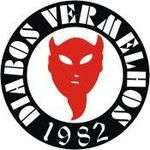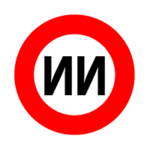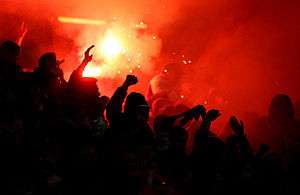Supporters of S.L. Benfica
S.L. Benfica is a Portuguese sports club based in Lisbon, formed in 1904 in Belém by a group of former Casa Pia students and members of Associação do Bem led by Cosme Damião.[1] It has been part of the Portuguese football top-flight, Primeira Liga, since the league's inception in 1934. Most notably, they have won the Primeira Liga 35 times, along with 25 Taça de Portugal and 2 European Cups.
The supporters of Benfica, who are called Benfiquistas, have played an important part in the growth of the club, during the club's 112-year existence. One of those cases was in the early days of the construction of the original Estádio da Luz when club president, Ferreira Bogalho, asked them for free concrete to build the stadium. They responded by offering 900,000 tons.[2] During the Estado Novo, the Censorship Services, prohibited the fans from referring to the football team as Vermelhos (Reds) so it was not confused with communism, instead being referred as Encarnados (Flesh-coloured), which is still used, even after the transition to democracy.[3][4]
There are three different types of supporters: one is the sócio or club member, who is eligible to vote in the presidential election of the club and other matters; The Houses (As Casas), which are closely affiliated with the sócios, are fan-clubs which have an eligible vote decided by the House leaders; and the ordinary fans of the club, who do not possess any formal membership.
Since 2005 club president, Luís Filipe Vieira, implemented an aggressive membership campaign with the intent of reaching 300,000 members.[5] From roughly 95,000 members in 2000,[6] the club reached 160,000 in 2006, a Guinness World record, only one year after the beginning of the campaign.[7] In the scheduled renumbering of 2015, Benfica dropped from 247,859 to 156,916 members, losing roughly 35% of their paying associates.[8]
Fanbase and attendances
| Season | Average attendance | Best avg. |
|---|---|---|
| 2005–06 | 43,057[9] | Yes |
| 2006–07 | 33,323[10] | No |
| 2007–08 | 37,558[11] | No |
| 2008–09 | 35,698[12] | No |
| 2009–10 | 50,033[13] | Yes |
| 2010–11 | 38,146[14] | Yes |
| 2011–12 | 42,530[15] | Yes |
| 2012–13 | 42,359[16] | Yes |
| 2013–14 | 43,613[17] | Yes |
| 2014–15 | 48,520[18] | Yes |
| 2015–16 | 50,322[19] | Yes |
Benfica are the best supported team in Portugal, according to research conducted by UEFA, with 47% of the total number of supporters.[20] Historically, Benfica have always been seen as working-class of Portugal,[21] growing exponentially as the club accumulated titles since the 1930s.[22] Their total number of supporters is an estimated 5.8 million fans in Portugal,[23] for a total fanbase of roughly 14 million worldwide.[24] In April 2010, Benfica launched a social network website for its supporters, SLB Fans; allowing users to create profile pages, interact with others, follow live matches coverages, receive exclusive messages from the team's players and managers, comment videos and photos and get access to players' statistical information.[25]
Since the beginning of 2005–06, where information regarding attendances was published, Benfica have been consistently one of Portugal's best attended teams, with an average gate above 42,250 over the course of eleven seasons. In eight of those seasons, it was the league's best, with 2015/16 being the best, finishing as Europe's 12th best average.[26][27]
Fans pay annually between €100 and €160 to be club members, enjoying discounts with some affiliated enterprises like Repsol, Caixa Geral de Depósitos, Hospital Lusiadas, as well lower prices in season tickets or merchandising.[28][29]
From the season ticket holders, matchday tickets, members fees, and merchadising, Benfica generate roughly €14 million per season.[30]
Filiations
Since 1911, Benfica has been creating filiations and delegations; independent entities that can play football or other sports, but are closely associated with Benfica, and were usually run by Benfica supporters, although this change in some cases. The first affiliated was Sport Lisboa e Portalegre, created by Leopoldo José Mocho, a club player at that time.[31] The first delegation was Estrela Futebol Clube in Braga, created in November 1914.[31] Some of these delegations have competed against Benfica, like the case of Lusitano in Algarve, that played in the Primeira Liga from 1947 to 1950. Other well known delegations are Sport Huambo e Benfica, Sport Luanda e Benfica and S.L. Benfica de Macau, the first competing in the Girabola and the latter in the Liga de Elite.[32]
Aside from delegations, Benfica also has Houses which are gathering places for fans, where they can buy merchadising or tickets, watch the club play, or pay members fees. Its creation started in the 1950s due to growing popularity of the club, the first being in Campo Maior, Alentejo.[33] As of May 2015, Benfica has 221 delegations, or houses.[34]
Supporters groups
During the Estado Novo, no organized supporters group existed, as few people had the resources to follow the club throughout the country or abroad. With the transition to democracy in the mid-1970s, and with the new found freedom, fans started to converge together to chant for their team, leading to the creation of the first supporters' groups in Portugal, Juve Leo, in 1976.
In Portugal, supporters' groups are obligated to register in Instituto Português do Desporto e Juventude (Portuguese Institute for Sport and Youth),[35] so that the club can provide technical, financial and material support to this groups. Neither Diabos Vermelhos nor No Name Boys have done so.[36][37]
Diabos Vermelhos
| Diabos Vermelhos | |
|---|---|
 | |
| Established | 16 November 1982 |
| Type | Supporters' group |
| Motto | Connosco Quem Quiser, Contra Nós Quem Puder |
| Colours | |
The Diabos Vermelhos (English: Red Devils) were created on 16 November 1982 and are located in the north corner of the Estádio da Luz, known as Topo Norte.
One of the oldest Portuguese supporters groups; they were formed when a group of fans gathered in the central ring of the original Estádio da Luz. Its creation was inspired by the European performance of 1982–83. They reached over five thousand members in the following years, [38] but in the early nineties, a disagreement resulted in the creation of another Benfica's supporters group No Name Boys. That affected negatively the group and members plummeted to an all-time low of just 10. But as new leaders came, they helped Diabos Vermelhos recover and regain members exponentially, reaching more than 1000 members.[39] Since the early days of No Name Boys, clashes between the two groups are frequent.[40][41]
In December 2003, they pressured Benfica's board, after the roller hockey section wanted to sign Paulo Alves, a former Porto player, who attacked one of their own during a match on 6 June 1998.[42][43]
On 24 January 2012, Diabos Vermelhos announced they were missing a match against Feirense because of high prices asked by Feirense, with the minimum ticket set at €25, where usually other teams are set at €10. They also protested against modern football profit-driven business, placing banners on nearby roofs.[44][45][46] Previously, in late 2010, Benfica requested their supporters to boycott away games due to the unequal prices they had to pay, in comparison with other teams.[47][48][49][50]
No Name Boys
| Иo Иame Boys | |
|---|---|
 | |
| Established | 4 March 1992 |
| Type | Supporters' group |
| Motto | SEMPRE PRESEИTES |
| Colours | |
The No Name Boys (Portuguese: Rapazes Sem Nome), or Иo Иame Boys, were created on 4 March 1992. They gather in the south corner of the Estádio da Luz, known as Topo Sul.
Created after disagreements in another Benfica's supporters group Diabos Vermelhos, the initial idea was to stick together and call themselves the Diabos Vermelhos. However, that name was already registered by head members of the remaining Diabos Vermelhos so they became a dissent group with no name, therefore the "Иo Иame Boys".[51]
They made an immediate impact in the Portuguese claques (supporters groups), with massive presence of its members on all Benfica matches, either home or away. The simple "NN" logo, standard red/white/black letters banners, powerful chants and displays and some fierce rivalry episodes with other groups made them the most popular Portuguese claque during the early 1990s.
On 18 September 1994, three No Name Boys members ‒ Jorge "Gullit" Maurício, Ana Rita Fernandes and Laurentino "Tino" Soares ‒ died in a car accident in Mérida, Spain when they were returning from a Benfica match against Hajduk Split for the UEFA Champions League.[52] From this event a friendship was made with Hajduk Split ultras Torcida Split.[53]
In 1996, after an incident during the Portuguese Cup final match, which resulted in the death of a Sporting supporter, they almost disbanded.[54] However, the group managed to survive, rebuild themselves and overcome the "criminal" image pictured by the media and Portuguese authorities. Also, the group created a unique style in the Portuguese supporters groups scene, distancing themselves from the traditional Italian-influenced ultras style, which was the lead current in Portugal during the 1990s and early 2000s.[51][55]
The group is known for its secrecy, with no leading figures known to the public-eye, no website and no open membership, unlike most of the Portuguese supporters groups. The No Name Boys rarely use elaborate displays at the stands and do not use any kind of sound support. They prefer a more simple approach, using only a few large flags, flares and their own vocal support. Salutes are often heard at the group's stand.[56]
They are well known for their devotion and passionate support for Benfica on all its sports and activities, specially football and futsal.[57][58] However, the group is also known by its unconditional defense of Benfica's best interests, being usual to see its members engaging in protests against the club board, staff or players whenever they feel things are not right. Those protests can be silent presences at the matches or explicit criticism at the club's members meetings.[59][60][61]
References
- ↑ Almanaque do Benfica (1 ed.). Lua de Papel. 2012. p. 11. ISBN 978-989-23-2087-8.
- ↑ Pereira 2014, p. 88.
- ↑ Pereira 2014, p. 157.
- ↑ "As Verdades Deturpadas da História do Benfica" [The Twisted Truths of Benfica History] (PDF). S.L. Benfica. pp. 19–20. Retrieved 5 May 2015.
- ↑ "Nove anos depois, Vieira insiste nos 300 mil sócios" [Nine years later, Vieira insists on 300,000 members]. Diário de Noticias (in Portuguese). 4 May 2014. Retrieved 5 May 2015.
- ↑ "Maisfutebol, 13 anos: que grande ganhou mais sócios?" [13 years: which three won more members?]. Maisfutebol.iol.pt. 5 June 2013. Retrieved 5 May 2015.
- ↑ "Most widely supported football club". guinnessworldrecords.com. 9 November 2006. Retrieved 5 May 2015.
- ↑ "Benfica perdeu 100 mil sócios" [Benfica lost 100 thousand members] (in Portuguese). Sapo Desporto. 14 August 2015. Retrieved 14 August 2015.
- ↑ "Historical attendances". European Football Statistics. Retrieved 6 July 2015.
- ↑ "Painel de espectadores por clube" [Attendance list per club] (in Portuguese). LPFP. Retrieved 3 July 2015.
- ↑ "Painel de espectadores por clube" [Attendance list per club] (in Portuguese). LPFP. Retrieved 3 July 2015.
- ↑ "Painel de espectadores por clube" [Attendance list per club] (in Portuguese). LPFP. Retrieved 3 July 2015.
- ↑ "Painel de espectadores por clube" [Attendance list per club] (in Portuguese). LPFP. Retrieved 3 July 2015.
- ↑ "Painel de espectadores por clube" [Attendance list per club] (in Portuguese). LPFP. Retrieved 3 July 2015.
- ↑ "Painel de espectadores por clube" [Attendance list per club] (in Portuguese). LPFP. Retrieved 3 July 2015.
- ↑ "Painel de espectadores por clube" [Attendance list per club] (in Portuguese). LPFP. Retrieved 3 July 2015.
- ↑ "Painel de espectadores por clube" [Attendance list per club] (in Portuguese). LPFP. Retrieved 3 July 2015.
- ↑ "Painel de espectadores por clube" [Attendance list per club] (in Portuguese). LPFP. Retrieved 3 July 2015.
- ↑ "Painel de espectadores por clube" [Attendance list per club] (in Portuguese). LPFP. Retrieved 31 July 2016.
- ↑ "The European Club Footballing Landscape" (PDF). UEFA.com. 17 April 2014. p. 41. Retrieved 5 May 2015.
- ↑ Willie Gannon (3 May 2013). "Dortmund vs. Bayern Munich and Europe's 6 Premier Rivalries Right Now". bleacherreport.com. Retrieved 5 May 2015.
- ↑ "SL Benfica". sportspundit.com. Retrieved 5 May 2015.
- ↑ Queirós, Eugénio (10 September 2012). "Benfica líder: 5,8 milhões de adeptos" [Benfica leader: 5.8 million fans] (in Portuguese). Record. Archived from the original on 2015-09-27. Retrieved 7 January 2013.
- ↑ "Plano Estratégico 2010-2013" [Strategic Plan 2010-13] (PDF). S.L. Benfica. 3 November 2010. p. 7. Retrieved 5 May 2015.
- ↑ "Benfica lança rede social para os adeptos" [Benfica launches social network for supporters] (in Portuguese). Sol. 30 April 2010. Archived from the original on 5 March 2012. Retrieved 23 December 2015.
- ↑ "EFS Attendances". European Football Statistics. Retrieved 31 July 2016.
- ↑ Paulo, Isabel. "Benfica é o 10.º clube europeu com maiores assistências" [Benfica is the 10th European club with the biggest attendances] (in Portuguese). Expresso. Retrieved 6 July 2015.
- ↑ "Quotas" [Fees]. SL Benfica. Retrieved 5 May 2015.
- ↑ "Sócio, estou concentradíssimo nos descontos" [Sócio, I'm focused on discount's]. Expresso. 28 August 2011. Retrieved 5 May 2015.
- ↑ "Relatório Financeiro 2013-14" [Financial Report 2013-14] (PDF). S.L. Benfica (in Portuguese). 8 January 2015. p. 36. Retrieved 5 May 2015.
- 1 2 Pereira 2014, p. 107.
- ↑ "História das Casas". S.L. Benfica (in Portuguese). Retrieved 5 May 2015.
- ↑ Pereira 2014, p. 32.
- ↑ "Benfica Supporters Clubs". S.L. Benfica.
- ↑ "Lei n.º 39/2009, de 30 de Julho". Procuradoria Distrital de Lisboa (in Portuguese). 30 July 2009. p. Article 14.
- ↑ "Diabos Vermelhos entre as três claques que não completaram registo no Conselho Nacional do Desporto" [Diabos Vermelhos among three supporters group which didn't registered with the Conselho Nacional do Desporto]. Diário de Noticias (in Portuguese). 20 December 2007. Retrieved 5 May 2015.
- ↑ "No Name Boys: claque continua ilegal" [No Name Boys: The group remains illegal]. tvi24.iol.pt (in Portuguese). 12 November 2008. Retrieved 5 May 2015.
- ↑ Pereira 2014, p. 211.
- ↑ "Diabos Vermelhos". sapo.pt.
- ↑ "Feridos em incidente entre claques" [People injured in clashes between groups]. Record. 6 January 2003. Archived from the original on 2015-07-01. Retrieved 5 May 2015.
- ↑ "Claques do mesmo clube em conflito" [Supporters groups from the same club in conflict]. Diario de Noticias. 27 April 2007.
- ↑ "Paulo Alves: "Era o projecto mais aliciante"" [Paulo Alves "It was the most exciting project"]. Record (in Portuguese). 27 December 2003. Archived from the original on 2015-10-01. Retrieved 21 January 2016.
- ↑ "José Carlos Franco pondera saída" [José Carlos Franco ponders resignation]. Record (in Portuguese). 3 January 2004. Archived from the original on 2015-10-01.
- ↑ "Diabos Vermelhos faltam ao jogo com o Feirense" [Diabos Vermelhos miss game against Feirense]. Record (in Portuguese). 24 January 2012. Archived from the original on 2015-10-01.
- ↑ "Benfica: grupo de adeptos protesta no topo de um prédio" [Benfica:Supporters group protest at the top of a building]. maisfutebol.iol.pt (in Portuguese). 28 January 2012.
- ↑ "Diabos Vermelhos protestam contra preço de bilhetes" [Diabos Vermelhos protest against ticket prices]. Correio da Manhã (in Portuguese). 24 January 2012.
- ↑ "Benfica pede aos adeptos para falharem jogos fora da Luz" [Benfica ask fans to miss away games]. Expresso.sapo.pt (in Portuguese). 13 September 2010. Retrieved 30 September 2015.
- ↑ ""Encarnados" decretam boicote aos jogos fora de casa e pedem a Vítor Pereira que se explique" ["Reds" decrete boycott to away games, and ask Vítor Pereira for explanations]. Público.pt (in Portuguese). 13 September 2010. Retrieved 30 September 2015.
- ↑ David Andrade (12 December 2010). "Vieira anuncia fim do boicote do Benfica aos jogos fora" [Vieira announces end of boycott to away games]. Público.pt (in Portuguese). Retrieved 30 September 2015.
- ↑ "Vieira decreta o fim ao boicote dos jogos fora da Luz" [Vieira decretes end of boycott to away games]. desporto.sapo.pt (in Portuguese). 12 December 2010. Retrieved 30 September 2015.
- 1 2 "O misterioso mundo dos No Name Boys" [The mysterious world of No Name Boys]. Diário de Notícias. 17 November 2008.
- ↑ "Jovens dos NN morrem em Espanha" [NN youngsters die in Spain]. O Benfica. September 2014. Retrieved 25 September 2014.
- ↑ "No Name Boys and Torcida jokes with Manchester United". footballtarget.com. 28 November 2011.
- ↑ "Adepto que disparou "very ligth" [sic] mortal detido no Estádio da Luz" [Fan that fired deadly flare, arrested in Estádio da Luz]. Jornal de Noticias. 7 November 2012.
- ↑ "No Name Boys: um historial de violência em tons de encarnado de norte a sul do país" [No Name Boys: A history of violence in red shaded colour, from north to south]. Diário de Notícias. 17 November 2008.
- ↑ "Um lema que diz tudo: 'No Name, No Net!'" [A motto than says everything: 'No Name, No Net']. Diário de Notícias. 20 November 2008.
- ↑ "NO NAME BOYS são imagem do dia do "The Guardian"" [No Name Boys are Picture of the day for The Guardian]. Relvado.sapo.pt. 27 April 2015. Retrieved 5 May 2015.
- ↑ "Jordy Smith: "Gosto de estar com os No Name Boys"" [Jordy Smith "I like to be with No Name Boys"]. Record. 10 October 2014. Archived from the original on 2015-10-01.
- ↑ "Protestos: Vieira desvaloriza contestação" [Vieira downplays unrest]. Correio da Manhã. 23 April 2012. Retrieved 5 May 2015.
- ↑ "Claque insulta Vieira, resto da Luz não gosta" [Supporters group insulted Vieira, remaining fans don't approve]. Maisfutebol. 22 April 2012. Retrieved 5 May 2015.
- ↑ "Benfica-PSG com protesto silencioso da claque" [Benfica-PSG with silent protest from supporters groups]. Maisfutebol. 10 December 2013.
Bibliography
- Pereira, Luís Miguel (2014). Bíblia do Benfica [Benfica Bible] (in Portuguese). Portugal: PrimeBooks. ISBN 9789896552152.
External links
| Wikimedia Commons has media related to Supporters of S.L. Benfica. |
- Official website (Portuguese)

